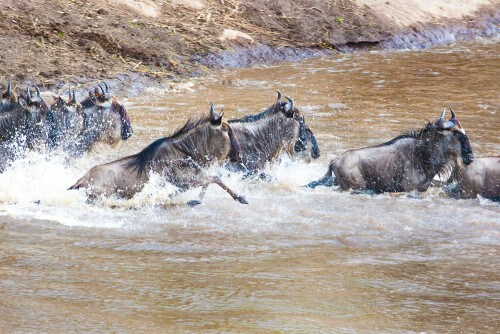They all migrate: salmon and eels migrate from the moment they mature to the rivers that are hatcheries for them. Tuna fish migrate between Japan and North America. In the Christmas Islands, about 50 million red crabs (Gecarcoidea natalis) migrate for about 2500 km from the land to the sea to lay eggs.

"In a body without rest is hidden a calm soul"... "Sailors and travelers have a distant goal". I don't know who said it, but anyone who visits the Serengeti Reserve in northern Tanzania will prove that the wildebeest herds (Connochaetes, -Wildebeest) joined by zebras and deer follow, illustrate and verify these things every year.
They all migrate: salmon and eels migrate from the moment they mature to the rivers that are hatcheries for them. Tuna fish migrate between Japan and North America. In the Christmas Islands, about 50 million red crabs (Gecarcoidea natalis) migrate for about 2500 km from the land to the sea to lay eggs.
Insects also migrate: dragonflies cross the Indian Ocean from India to East Africa, the most well-known and observed insect migration is the migration of swarms of the royal Danaus (Danaus plexippus) between the northern United States and Mexico, a migration that spans three generations and depends on Ascalpian bushes. The most harmful migration is the migration of locust swarms that destroy everything that grows.
poultry:
Every year about 1800 species of birds migrate from place to place. In the spring and autumn, about half a billion birds pass over us (over Israel) that migrate between Western Asia - Northern Europe and Africa.
Until the end of the nineteenth century, billions of migratory pigeons (Ectopistes migratorius) that migrated between North and South America covered the sky and darkened the day, the last flock of about a million individuals was destroyed (in a hunting competition) in 1896.
Flocks of bald geese (Anser indicus) fly over the Himalayan range. The one who covers the greatest distance in migration is (without a doubt) the Arctic Tern (Sterna paradisaea) which migrates from the North Pole to the South Pole and back every season.
mammals
Like the polar gull, whales also migrate from pole to pole. Reindeer (Rangifer tarandus) migrate in the north of America between the pastures. In Zambia, about eight million fruit bats (Eidolon helvum) migrate over short distances, and in South Sudan, thousands of deer (Kobus kob leucotis) migrate between seasonal pastures. The largest of the land migrants are the elephants that migrate in the Sahara in Mali.
All of them migrate, following the food, to find mates and engage in pro-verbo, to escape from the cold or the heat (and some also migrate to escape from enemies).
The most well-known and observed migration is the wildebeest migration in East Africa - more than a million wildebeest joined by tens of thousands of zebras and hundreds of deer "produce" one of the most special sights when they "follow the rain" that grows pasture.
The seasonal migration takes place in an area that has grown to about 40 thousand square kilometers in an elliptical path that is between 2,500 and 3,000 km long. There are those who mark the starting point of the migration in April, when the first wildebeest begin to move from the south of the Serengeti (in Tanzania) towards the north. On their way, the first migrating herds "collect" many herds until a herd of about 1.2 million individuals and a length of about 40 km is formed, joined by about 250 thousand zebras.
The sharing between zebras and wildebeest stems from the fact that the wildebeest prefer the fresh and soft grass, while the zebras are satisfied with the lower and harder parts of the grass.
In the months of May and June, the huge herd reaches the banks of the Grumeti River and there, as if by magic, the herd splits into two, a small group where mostly mature animals stay around the river, the larger group with many young ones continues north and crosses the first obstacle. The river, the water in the river is shallow and has crocodiles waiting for the seasonal feast. Along the route, the herd is accompanied by many predators - lions, cheetahs, tigers and hyenas. Some researchers claim that the "smart" zebras place themselves in the center of the herd and thus are protected compared to the less cautious wildebeest. Unlike wildebeests who continue almost without considering obstacles, zebras stop and look for safe alternatives.
In the months of June to August the herd reaches Masai-Mara, and again has to cross a crocodile-infested river - the Marra River. Masai Mara is a relatively small reserve, but researchers claim that despite its small area (1500 square kilometers), the reserve can "support" about two million animals for about two months.
After about two months the grass in Masai Mara is already dry and missing. The herds are now moving south back to the Serengeti, they are reaching areas where it has rained. While moving south, the males "collect" groups of females for themselves. The grass that grows, green and fresh provides a lot of food that enables the more important feature...pro and rebo.
The months of January and February are the calving season, the area is crowded with calving, the mass calvings ensure the survival of more calves (the more calves there are, the less chance of predation). Between March and June it rains in Masai Mara and grass grows again and waits for the next wave. And this is how one of the most impressive and special migration cycles takes place, a migration that provides a unique experience for visitors.

One response
It is desirable that another article on the subject, the author will scan and explain the various existential reasons
which motivate all the types of migration listed, if they are known.
True, the wildebeest migrates following the rain, but what motivates the other types of migration, of
The birds, the insects, the whales and also...of the Jews?